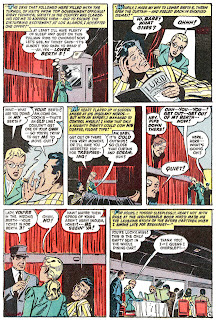My heart swelled when I read this touching story of a girl who achieved greatness in her field — nuclear physics — only to find failure in love. Tsk, tsk. The only guy who really loved her was a boorish carny barker who embarrassed her endlessly. She fell for the sinister Frenchman who lead her astray, all the way to a cabin in the woods where we assume he wanted his way with her, only to find out he wanted to pick her nuclear brain!
This entertaining love story is from ACG’s Search For Love #2 (1950). In the comments section for this post comic art historian Alberto Becattini has named the artist as John Celardo. Thanks to Alberto for helping with that identification.
Search For Love was very short-lived, only two issues. I don't know why unless sales were bad. Yet ACG’s other love comics, Lovelorn and Romantic Adventures continued for years. It may have been cancelled because of the expanding ACG line taking resources that would have gone into Search For Love. That's a way of saying I don’t know why, trying to sound smarter than I am (no nuclear scientist, I) and now I’m kinda sorry I brought it up...














Hello Pappy.
ReplyDeleteThe artist is John Celardo, better known for his Tarzan strips and pages, who passed away last year.
Keep up the excellent work.
Best,
Alberto
Wow. Where to begin!
ReplyDeleteAs for the artist, some of the female figures look a lot like Wood (maybe a very quick and dirty Wood), and the last page looks much more finely rendered than any of the others. Possible Williamson, too, or a studio effort? It's certainly a quick job. More than likely, somebody who aped them, though.
The story ... well, some writer got turned down for a date or had a wife that yelled at him for not be cultured or smart enough, I guess!
The take-away from this tale is when I constantly insult a woman, then basically molest her in a train car, if I manage to avoid getting arrested, I'll hire some actor to pretend to be a French-disguised Nazi to seal the deal!
Interesting that this can be read as a sort of double-Cinderella story. Lorraine can be conceptualized as the nerdy girl who gets the jock. Eddy can be conceptualized as the poor boy who gets the sophisticated beauty.
ReplyDelete[Soapbox Warning!]
For my part, I have a problem with most Cinderella stories. The implications seem to be that the poor-but-honest nerdy boy is too good for the poor-but-honest nerdy girls, or the poor-but-honest nerdy girl is too good for the poor-but-honest nerdy boys, and that cheerleaders and jocks are in some meaningful way generally better than poor-but-honest nerdy people, except in the case of Our Hero(ine), whose inner better-ness needs just to be seen.
The non-cheerleader who wants the jock to see her inner goodness and the non-jock who wants the cheerleader to see his inner goodness each need to consider what sort of inner goodness they aren't seeing amongst non-jocks and non-cheerleaders.
Brian, as you can see from the comment above yours Alberto Becattini says John Celardo, a long-time journeyman comic artist, did the drawing.
ReplyDeleteDaniel, no problem with your soapbox oration...I believe you're right about the Cinderella stories. I think love comics were a fantasy, modern fairy tales, not unlike super heroes and power fantasies for young males, that allowed girls and women to dream of attaining something (in this case undying love and devotion)they might be longing for in real life. Hey, we can all dream!
In this particular story one of the things I liked was showing a woman as a brainy scientist, not something we saw much in fiction of generations past.
Pappy,
ReplyDeletephilsp.com doesn't list a magazine titled Lurid, so we'll just guess that's a come-on on the cover, not the title. It's an interesting detail to our introduction to Eddy Jackson.
The villain's name is, I suppose, meant to remind us of Antoine Lavoisier. Antoine was married to Marie-Anne Paulze in 1771 and remained so until his death in the Paris Terror in 1794 but I don't recall any offspring?
The GCD doesn't note it for this issue, but isn't it common knowledge that Richard Hughes wrote all these stories?
Thanks,
Darci
Darci, I don't know if Hughes wrote this story; he wrote ACG's output after a certain point (1955?), but in the early days of ACG there was at least one other writer (who often used the exclamation "Ye Gods!" in his stories).
ReplyDelete